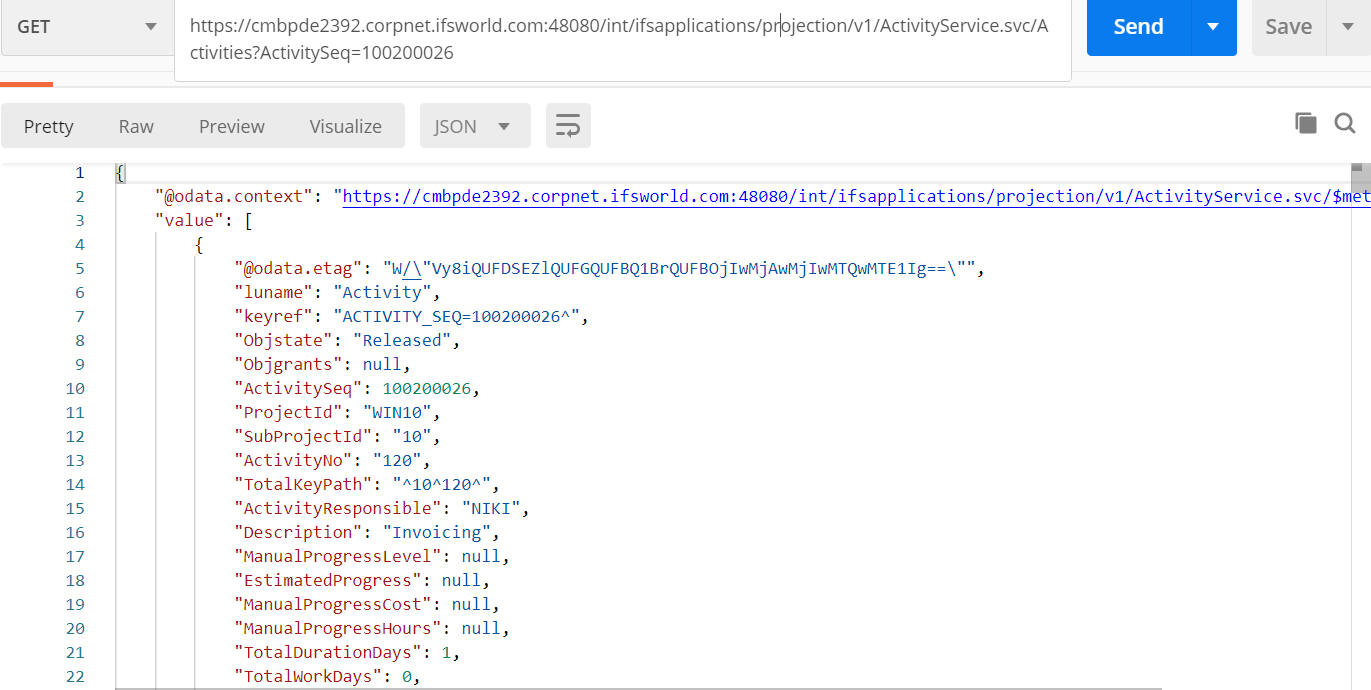Using IFS RESTful APIs
Contents
IFS has a multitude of RESTful ODATA APIs that can be
used when you want to integrate with, or extend IFS Applications.
You can read more about the concept
here.
Postman is a popular tool used to test API's .In the
following sections Postman has been used to demonstrate functionalities of IFS
API's.
In the given examples we will be using HTTP basic
authentication by enabling 'Compatibility Application Type' attribute. To learn
how to authenticate using oAuth click
here.
You need to know the request URL and the HTTP
method to test a request and there are many ways to achieve this.
Fetching data without parameters (GET Operation)
-
Get the Request URL for the needed GET request
https://host:port/int/ifsapplications/projection/v1/ActivityService.svc/Activities
-
Construct the request with the use of OpenAPI or
Odata specification adhering to following standard.
https://<server>/<resource-path>

-
If the request is successful server will return 200
(OK) status along with the relevant data.

Figure 4
Note: When server returns a large
amount of data there might be performance issues, to improve this use query
options.
Fetching data with parameters (GET operation)
-
Construct
the request URL https://<server>/<resource-path>In
the Params section under query params provide the Key of the parameter and
the corresponding value.
The relevant data is returned
Figure 5
Creating a resource ( POST operation )
-
Construct the request URL as
https://<server>/<resource-path>
-
Set the body data under Body tab. Select raw and JSON type and add the
necessary data.

-
If the operation is
successful status 201 would return
Deleting a resource ( DELETE Operation )
-
1.
Construct the request URL https://<server>/<resource-path>(ParameterKey=ParameterValue)
provide the Key of the parameter and the corresponding value to be deleted.

- In the
headers section provide If-Match as the key and for the value provide the E-Tag
value, In addition for Accept Key provide application/json as the value

- If
the resource is successfully deleted 202 will return as the status value.
Updating a resource ( PATCH Operation )
1. Construct the request URL as
https://<server>/<resource-path>

2. In the headers section add Content-Type as the Key
and provide application/json as the value.

3. In the body section select raw and JSON as the type
and add the required key value pairs needed for the specific modify
functionality.

4. If the call is successful 200 is returned as the
status code and the resource with the updated values is shown.

- In a UD operation – A precondition is Missing in
the request

Solution – Add If-Match key for headers and for value provide
the E-Tag
- When uploading a file - Unexpected internal server error occurred.

Apart from that, the following errors appear in odp-default-log file in
<ifs_home>\instance\<instance_name>\logs\odata-provider\<endpoint> folder.
detected.com.ifsworld.fnd.provider.processor.FndErrorProcessor.processError() : Illegal base64 character 2b
Solution - When sending Base 64 encoded filename using “X-IFS-Content-Disposition” header via REST API, it should be encoded
to support Base 64 URL encoding standard. (Base 64 encoded string should not contain plus (+) and slash (/) characters.)
Query options are a set of parameters that we can pass through
the URL and control the amount of data that is being returned from the ODATA
Service. IFS ODATA services supports system Query options. For more details
click
here.
Query options help in performance aspects
The network
performance can be managed by using query options such as $filter,
$select, $top
and $skip by managing the chunk of data that is sent back from the server.
$filter option can further restrict the data that is being returned by the URL
by filtering a collection of resources that are addressed by a request URL.
$select option allows clients to requests a specific set of properties for each
entity or complex type. This reduces network load.
When going through a
large number of data records, using the $top and
$skip options the client can
request only specific pages of items.
Examples using query options
To only
get the first 50 results

Using a combination of query options
















